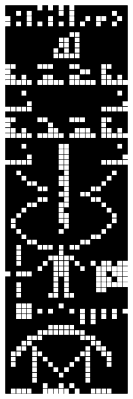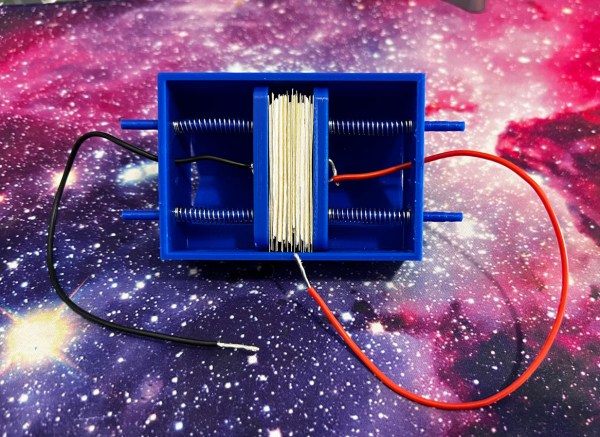In the technologically-underpinned modern world, most of us interact with a battery of some sort every day. Whether that’s the starter battery in a car, the lithium battery in a phone, or even just the coin cell battery in a wrist watch, batteries underpin a lot of what makes society possible now. Not so in the early 1800s when chemists and physicists were first building and experimenting with batteries. And those batteries were enormous, non-rechargable, and fairly fragile to boot. Not something suited for powering much of anything, but if you want to explore what it would have been like to use one of these devices, follow along with [Christopher]’s build of a voltaic pile. Continue reading “The Voltaic Pile: Building The First Battery”
News3633 Articles
New Drug Has Potential As Dirty Bomb Antidote
It perhaps goes without saying that one nuclear bomb can really ruin your day. The same is true for non-nuclear dirty bombs, which just use conventional explosives to disperse radioactive material over a wide area. Either way, the debris scattered by any type of radiation weapon has the potential to result in thousands or perhaps millions of injuries, for which modern medicine offers little in the way of relief.

But maybe not for long. A Phase 1 clinical trial is currently underway to see if an oral drug is able to scour radioactive elements from the human body. The investigational compound is called HOPO 14-1, a chelating agent that has a high affinity for metals in the actinide series, which includes plutonium, uranium, thorium, and cerium curium. Chelating agents, which are molecules that contain a multitude of electron donor sites, are able to bind to positively charged metal ions and make the soluble in aqueous solutions. Chelators are important in food and pharmaceutical processing — read the ingredients list on just about anything from a can of soda to a bottle of shampoo and you’re likely to see EDTA, or ethylenediaminetetraacetic acid, which binds to any metal ions that make it into the product, particularly iron ions that come from the stainless steel plumbing used in processing equipment.
The compound under evaluation, HOPO 14-1, is a powerful chelator of metal ions. Its structure is inspired by natural chelators produced by bacteria and fungi, called siderophores, which help the microorganisms accumulate iron. Its mechanism of action is to sequester the radioactive ions and make them soluble enough to be passed out of the body in the urine, rather than to have the radioactive elements carried around the body and incorporated into the bones and other tissues where they can cause radiation damage for years.
HOPO 14-1 has a number of potential benefits over the current frontline chelator for plutonium and uranium toxicity, DTPA or diethylenetriaminepentaacetic acid. Where DTPA needs to be injected intravenously to be effective, HOPO 14-1 can be made into a pill, making stockpiling and administering the drug easier. If, of course, it passes Phase 1 safety trials and survives later trials to determine efficacy.
Bankruptcy Sale Scatters Virgin Orbit To The Winds
When Virgin Orbit filed for bankruptcy in April, it was clear the commercial launch provider was in serious trouble. Despite successfully putting four payloads into low Earth orbit, the spin-off of Richard Branson’s Virgin Galactic space tourism company had struggled to achieve a high enough launch cadence to become profitable, and had recently suffered a highly-publicized failure when their first launch from the UK from the newly-completed Spaceport Cornwall ended in a complete loss of the vehicle.
There was some hope that a buyer would swoop in and save them at the last minute, but now that the bankruptcy auction has spread out the company’s assets among several other players in the commercial launch industry, Virgin Orbital is officially no more. With future launches now off the table, the company’s remaining employees are set to be let go as operations wind down over the coming weeks.
Continue reading “Bankruptcy Sale Scatters Virgin Orbit To The Winds”
Simulated ET To Phone Home From Mars This Afternoon
In science fiction movies, communicating with aliens is easy. In real life, though, we think it will be tough. Today, you’ll get your chance to see how tough when a SETI project uses the European Space Agency’s ExoMars Trace Gas Orbiter to send a simulated alien message to the Earth. The transmission is scheduled to happen at 1900 UTC and, of course, the signal will take about 16 minutes to arrive here on planet Earth. You can see a video about the project, A Sign in Space, below.
You don’t need to receive the message yourself. That will be the job of observatories at the SETI Institute, the Green Bank Observatory, and the Italian National Institute for Astrophysics. They’ll make the signal available to everyone, and you can join others on Discord or work solo and submit your interpretation of the message.

There are a host of issues involved in alien communication. What communication medium will they use? How will they encode their message? Will the message even make sense? Imagine an engineer from 1910 trying to find, decode, and understand an ad on FM radio station 107.9. First, they’d have to find the signal. Then figure out FM modulation. Then they’d probably wonder what the phrase “smartphone” could possibly mean.
When [Frank Drake] created a test message to send to aliens via the Arecibo dish, almost no one could decode it unless they already knew how it worked. But even looking at the message in the accompanying image, you probably can only puzzle out some of it. Don’t forget; this message was created by another human.
If you want a foreshadowing of how hard this is, you can try decoding the bitstream yourself. Of course, that page assumes you already figured out that the stream of bits is, in fact, a stream of bits and that it should be set in an image pattern. You also have the advantage of knowing what the right answer looks like. It could easily become an extraterrestrial Rorschach test where you find patterns and meaning in every permutation of bits.
Speaking of the Drake message, it saddens us to think that Arecibo is gone. The closest we think we’ve come to intercepting alien messages is the Wow signal.
Continue reading “Simulated ET To Phone Home From Mars This Afternoon”
THOR Microwaves Drone Swarms
In recent years small drones have gone from being toys and photography tools to a deadly threat on the battlefield. Kamikaze drones have become especially prominent in the news due to their use in the war in Ukraine by both sides. While we haven’t seen coordinated swarms being actively employed on the modern battlefield, it’s likely only a matter of time, making drone swarm defense an active field of development in the industry.
The US Air Force Research Laboratory recently conducted tests and a demonstration of an anti-drone weapon that uses pulses of high-power microwave energy to fry the electronics of a swarm of drones. Named the Tactical High-power Operational Responder, or THOR (presumably they picked the acronym first), it’s housed in a 20ft shipping container with large microwave antenna on top. The form factor is important because a weapon is only useful if it can reach the battlefield, and this can fit in the back of a C130.
THOR likely functions similarly to a shotgun, with a relatively large effective “beam.” This would have added advantages like frying multiple drones with one pulse and not needing pinpoint tracking and aiming tech required for projectile and laser-based weapons. Depending on its range and directivity, THOR might come with the downside of collateral damage to electronics close to its line of fire.
Drone swarms are of course the other side of this arms race, but fortunately they also have non-destructive uses like lights shows and perhaps even 3D printing.
Faster Glacier Melting Mechanism Could Cause Huge Sea Level Rises
When it comes to the issue of climate change, naysayers often contend that we have an incomplete understanding of the Earth’s systems. While humanity is yet to uncover all the secrets of the world, that doesn’t mean we can’t act on what we know. In many cases, as climate scientists delve deeper, they find yet more supporting evidence of the potential turmoil to come.
In the stark landscapes of Greenland, a team of intrepid researchers from the University of California, Irvine, and NASA’s Jet Propulsion Laboratory have unearthed a hidden facet of ice-ocean interaction. Their discovery could potentially flip our understanding of sea level rise on its head.
Continue reading “Faster Glacier Melting Mechanism Could Cause Huge Sea Level Rises”
This Week In Security: .zip Domains, Zip Scanning
The world may not be ready, but the .zip Top Level Domain (TLD) is here. It’s a part of the generic TLD category, which was expanded to allow applications for custom TLDs. Google has led the charge, applying for 101 such new TLDs, with .zip being one of the interesting ones. Public registration for .zip domains has been open for a couple weeks, and some interesting domains have been registered, like update.zip, installer.zip, and officeupdate.zip.
The obvious question to ask is whether this new TLD can be abused for scamming and phishing purposes. And the answer is yes, sure it can. One of the trickiest ways is to use the AT symbol @ in a URL, which denotes user info at the beginning of the URL. It usually is used to include a username and password, like http://username:password@192.168.1.1/. That is pretty obvious, but what about https://google.com@bing.com? Still looks weird. The catch that really prevents this technique being abused is that slashes are disallowed in user data, so a abusive URL like https://google.com∕gmail∕inbox@bing.com is right out.
Except, take a look at that last link. Looks like it has slashes in it, so it should take you to google, and ignore the AT symbol. But it doesn’t, it goes to Bing. You may have guessed, it’s Unicode shenanigans again. Those aren’t slashes, they’re U2215, the division slash. And that means that a .zip TLD could be really sneaky, if the apparent domain is one you trust. Continue reading “This Week In Security: .zip Domains, Zip Scanning”

















